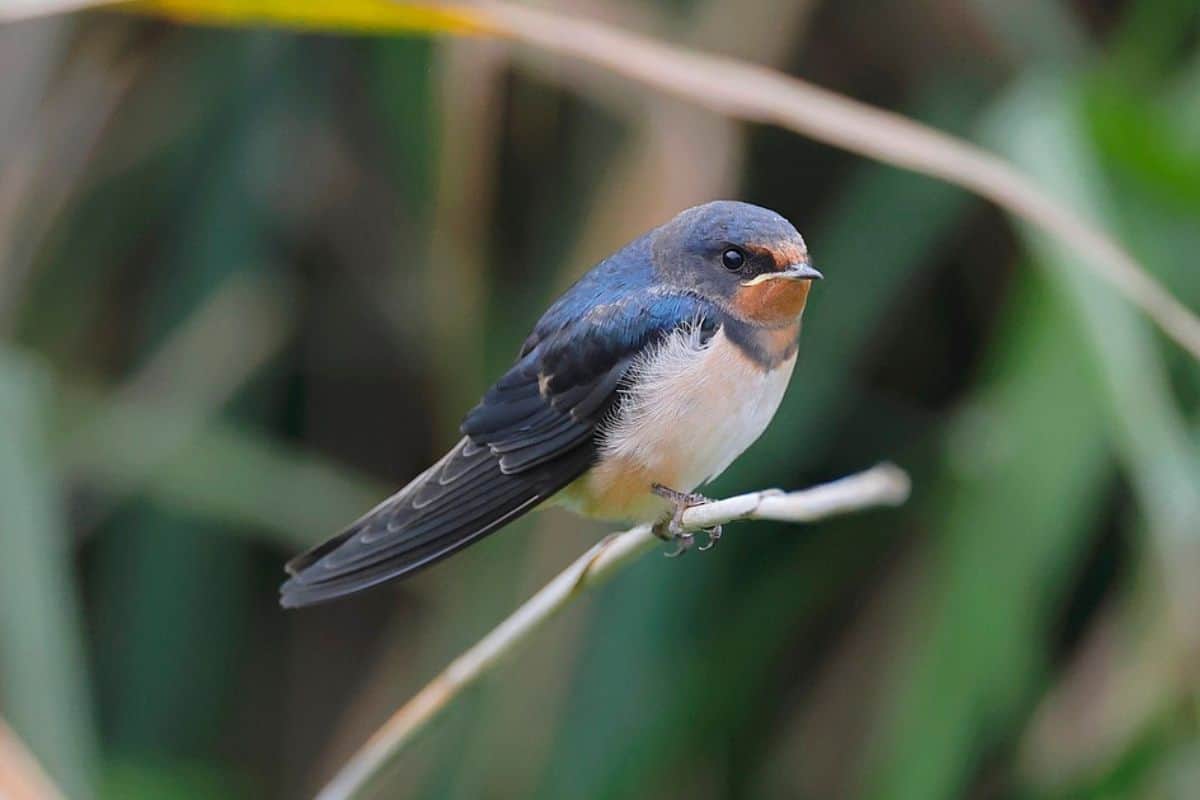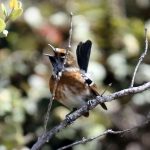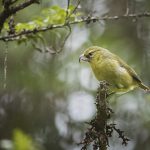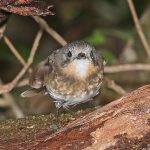Common Name: Barn Swallow
Scientific Name: (Hirundo rustica)| Size | Diet | Range in Hawaii | Status in Hawaii |
|---|---|---|---|
| 6.7 in. - 7.5 in. | flies, beetles, moths, bees, and wasps | Kure and Midway Islands | Least Concern |
The Barn Swallow (Hirundo rustica) is a small and agile bird species that is known for its distinctive forked tail and graceful flight. With its sleek blue and rust-colored plumage, this swallow is a beloved sight in its natural habitat. Although it is not a native species to Hawaii, Barn Swallows have been spotted occasionally on the islands as non-breeding visitors or vagrants, making for a rare and exciting sighting for birdwatchers.
In this article, we’ll explore the fascinating world of the Barn Swallow and learn more about its unexpected presence in Hawaii.
Barn Swallow
Appearance
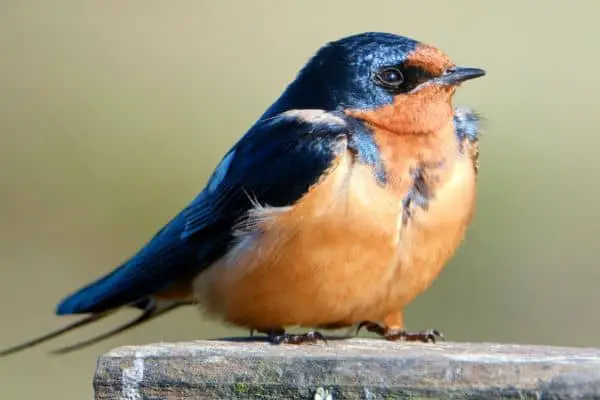
The Barn Swallow is a medium-sized bird with a distinct appearance. It has a sleek and slender body, measuring approximately 6.7 to 7.5 inches (17 to 19 centimeters) in length. The wingspan of the Barn Swallow ranges from 11.4 to 12.6 inches (29 to 32 centimeters).
Barn Swallows have a unique coloration with a dark blue-black upper body, including their wings and back. Their forehead, throat, and upper breast are a rusty red color, while the rest of the underparts are off-white. They have a deeply forked tail with elongated outer feathers, giving them their characteristic “swallowtail” appearance.
The Barn Swallow also features a long, pointed pair of wings that enable them to perform agile aerial maneuvers. Their beak is short and black, and they have small, dark eyes. Male and female Barn Swallows have similar appearances, although males may have slightly longer tail streamers.
Diet
The diet of the Barn Swallow primarily consists of insects. As an aerial insectivore, it relies on its agility and speed to catch prey while in flight. Barn Swallows feed on a wide variety of flying insects, including flies, beetles, moths, bees, and wasps. They are particularly skilled at capturing insects on the wing, snatching them with their beak or even scooping them up with their wide, gaping mouth.
These birds are adept at foraging in open areas, such as meadows, fields, and bodies of water where insects are abundant. They often perform aerial acrobatics, swooping and diving to catch their prey. Barn Swallows are known to feed in groups, especially during peak insect activity.
Nesting
The Barn Swallow constructs its nests using a combination of mud and grass. They typically build their nests in sheltered locations such as the eaves of buildings, barns, or other structures.
The nest is cup-shaped and consists of mud pellets, which the birds collect in their beaks and then mold into the desired shape. They reinforce the nest with a lining of fine grasses, feathers, and other soft materials.
The female Barn Swallow takes the lead in nest building, while the male assists by providing materials. The nest is meticulously constructed, and both birds work together to create a sturdy and cozy structure. The location of the nest is essential for protection against predators and to provide a safe environment for their eggs and chicks.
Once the nest is complete, the female lays a clutch of eggs, usually numbering four to six. The eggs are white with speckles or spots of brown. The female incubates the eggs while the male provides her with food.
After about two weeks of incubation, the eggs hatch, and the parents diligently care for the nestlings. Both parents take turns feeding the chicks a diet of insects, regurgitating food into their mouths.
As the nestlings grow, they become more active and develop feathers. After approximately two to three weeks, the young Barn Swallows are ready to leave the nest, but they continue to depend on their parents for food and guidance. The parents continue to care for their offspring until they become independent and capable of flying on their own.
Behavior
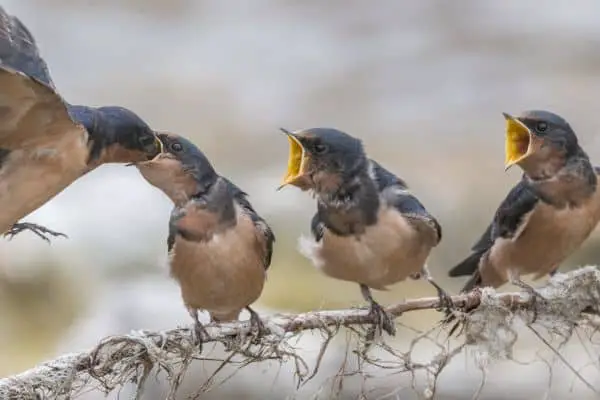
The Barn Swallow displays fascinating behavior that showcases its adaptability and remarkable flying abilities. Known for its graceful and agile flight, this bird effortlessly maneuvers through the air with swift movements, including swoops, dives, and rapid changes in direction. Its long, forked tail adds to its elegance, making it easily recognizable in flight.
One of the most notable aspects of the Barn Swallow’s behavior is its impressive migratory journey. These birds undertake long-distance migrations, traveling between their breeding grounds in the Northern Hemisphere and their wintering grounds in Central and South America, Africa, and southern Asia. They embark on this arduous journey each year, covering thousands of miles, to take advantage of favorable weather and abundant food resources.
Barn Swallows are highly social birds and often form small to large colonies during the breeding season. They are known to exhibit strong pair-bonding behavior, with mated pairs returning to the same nesting sites year after year.
These birds construct cup-shaped nests made of mud and grass, typically in the eaves of buildings or other structures. They show exceptional nest-building skills and invest considerable effort in creating sturdy and cozy homes for their eggs and chicks.
In terms of diet, Barn Swallows are insectivores, specializing in catching flying insects on the wing. They have a keen ability to detect and pursue their prey, performing acrobatic aerial maneuvers to snatch insects from the air.
Their diet primarily consists of flies, beetles, moths, and other small insects. By controlling insect populations, Barn Swallows play a vital ecological role in maintaining the balance of ecosystems.
Habitat
The Barn Swallow is a highly adaptable bird species that occupies a wide range of habitats across its breeding and wintering grounds. In general, they prefer open areas with access to water, such as fields, meadows, wetlands, and open woodlands. Barn Swallows have a strong association with human-made structures, including barns, sheds, bridges, and other buildings, where they construct their nests.
Their preference for nesting near human settlements is partly due to the availability of suitable nest sites, such as the eaves and rafters of buildings, which provide shelter and protection. These structures mimic the natural nesting sites found in cliffs and caves. Barn Swallows have successfully adapted to nesting in human-altered environments and have become a familiar sight in rural and urban areas.
Water sources are crucial for Barn Swallows, as they require access to wetlands, ponds, rivers, or other bodies of water for drinking and foraging. These areas attract a variety of flying insects, which form the primary food source for Barn Swallows. The proximity of suitable foraging habitats to their nesting sites is essential for their survival and successful breeding.
During migration and winter, Barn Swallows inhabit a broader range of habitats. They are often found in open grasslands, savannas, agricultural fields, and coastal areas. These habitats provide an abundance of insects and suitable roosting sites.
Range
The Barn Swallow is a species that has a vast range extending across the globe. In Hawaii, the Barn Swallow has been documented in various locations. Records show that they have been observed on Clipperton Island, Micronesia (including the Marshall Islands), and on several occasions in the Hawaiian Islands.
Specifically, sightings have occurred in the Northwestern Hawaiian Islands, such as Kure and Midway Islands. In the Southeastern Hawaiian Islands, there is also one confirmed record of a Barn Swallow observed on Hawaii Island near Volcano National Park. These sporadic occurrences highlight the migratory nature of the Barn Swallow, as it travels to different parts of the world, including Hawaii, for breeding and wintering.
Conservation Status

The Barn Swallow is currently listed as a species of “Least Concern” by the International Union for Conservation of Nature (IUCN). This classification indicates that the species is not facing immediate threats to its survival and has a relatively stable population.
Barn Swallows have a wide distribution and large global population, with estimates ranging in the hundreds of millions. They have adapted well to human-altered habitats, including agricultural areas and human-made structures, which has helped them maintain stable populations in many regions.
Interesting Facts
1. Long-distance migration
Barn Swallows are known for their remarkable long-distance migration. They undertake extensive journeys, traveling thousands of miles from their breeding grounds in the northern hemisphere to their wintering grounds in the southern hemisphere.
2. Acrobatic flyers
Barn Swallows are highly agile and acrobatic in flight. They are known for their elegant, swooping flight patterns and their ability to catch insects on the wing with great precision.
3. Vocal communicator
Barn Swallows have a melodious song consisting of a series of warbling notes. Their vocalizations are used for communication during courtship, territorial defense, and maintaining contact with their flock.
4. Distinctive forked tail
One of the key features that distinguish Barn Swallows is their deeply forked tail. The two elongated tail feathers give them a graceful appearance and aid in their maneuverability during flight.
5. Cooperative breeding behavior
Barn Swallows often exhibit cooperative breeding, where multiple adults, including non-breeding individuals, assist in raising the young. This cooperative behavior helps improve the reproductive success of the breeding pair.
Frequently Asked Questions
1. Are Barn Swallows monogamous?
Yes, Barn Swallows are monogamous birds. They form long-term pair bonds and typically mate with the same partner each breeding season.
2. Do Barn Swallows migrate together in flocks?
Barn Swallows usually migrate in small groups or loose flocks, although they may also migrate individually. They often join larger flocks of other migrating birds during their journeys.
3. How long do Barn Swallows live?
Barn Swallows have an average lifespan of 4 to 6 years, but some individuals have been known to live up to 12 years.
4. How do Barn Swallows communicate with each other?
Barn Swallows communicate through a combination of vocalizations and body language. They produce a variety of calls, including chirps, trills, and alarm calls, to convey messages to other swallows.
